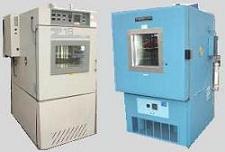Temperature,
Humidity, Bias (THB) Test
Temperature,
Humidity, Bias (THB)
testing is a reliability test designed to
accelerate
metal corrosion, particularly that of the metallizations
on the die surface of the device.
Aside from
temperature
and
humidity
which are enough to promote corrosion of metals in the presence of
contaminants,
bias
is applied to the device to provide the potential differences needed to
trigger the corrosion process, as well as to drive mobile
contaminants to areas of concentration on the die.
THB
testing employs the following stress conditions:
1000 hours at
85 deg C,
85% RH, with
bias applied to the
device. The bias applied is usually designed to simulate the bias
conditions of the device in its real-life application, maximizing
variations in the potential levels of the different metallization areas
on the die as much as possible.
Surface-mount devices are also
preconditioned
prior to THB testing. During THB proper, intermediate readpoints at 48H, 96H, 168H, and
500H are often used. This gives look-ahead reliability data as the
THB test progresses.
The
main drawback of THB is its long
duration, necessitating weeks before useable data are obtained.
Because of this, an alternative test, the HAST, has been developed. HAST uses more severe stress
conditions but can be completed in only 96 hours. Its shorter
duration is an advantage that makes it a more popular stress test in the
industry.
 |
|
Fig.
1.
Examples of Temperature/Humidity Chambers
|
Reliability
Tests:
Autoclave
Test or PCT; Temperature
Cycling; Thermal
Shock;
THB;
HAST;
HTOL;
LTOL;
HTS; Solder
Heat Resistance Test (SHRT);
Other
Reliability Tests
See Also:
Reliability
Engineering;
Reliability Modeling; Qualification
Process; Failure
Analysis;
Package Failures; Die
Failures
HOME
Copyright
©
2001-Present
www.EESemi.com.
All Rights Reserved.

